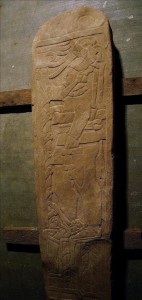 A 1000-year-old stele engraved with the image of a Mayan ruler was found in the Lagartero archaeological area of Chiapas, Mexico. Archaeologists found the bas relief late last year while excavating the 10th section of Pyramid 4 in Lagartero.
A 1000-year-old stele engraved with the image of a Mayan ruler was found in the Lagartero archaeological area of Chiapas, Mexico. Archaeologists found the bas relief late last year while excavating the 10th section of Pyramid 4 in Lagartero.
The stele depicts the ruler standing above a man at his feet, probably representing a seizure of power.
Archaeologist Sonia Rivero Torres, who heads the Lagartero archaeological project, said that the stele or commemorative monument – the first to be found complete on the site – measures 2 meters (6 1/2 feet) long, 55 centimeters (22 inches) wide and 6 centimeters (2 1/3 inches) thick.
The stele was sculpted in metamorphic rock, known locally as “heart of stone.”
“In the pre-Colombian monument the profile image of a Mayan ruler is seen standing over a bench carrying a bag of incense in one hand and dressed in a loincloth bound with a sash and wearing sandals and a feather headdress.
“At his feet, lying on his back on the bench, lies another, smaller person with his torso opened as a sign of sacrifice or of being overthrown,” the archaeologist said.
It was found during the excavation of a stone casket which turned out to be empty, probably looted in pre-Columbian times.
A little further down in the pyramid, archaeologists found earthenware pots, a polychrome plate, a black vase with a zoopmorphic lid with a collection jade objects insides, including two earflaps, a turtle and a bead necklace.
Earlier, archaeologists found a box full of vessels of different shapes, zoomorphic vases and even a few human bones were recovered.
Lagartero was occupied for almost a thousand years, between 300 A.D. and 1200 A.D., and is a 2 1/2 acre ceremonial center. The area was a crux of trade between what are now Mexico and Guatemala as well as a religious and cultural capital. Not only have the pyramids provided rich finds, but the grounds have turned up a ball-playing court too.
Authorities plan to open the archaeological area for visitors some time this year.